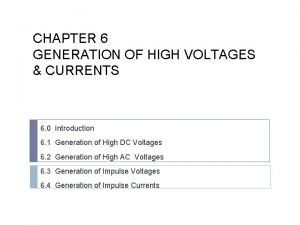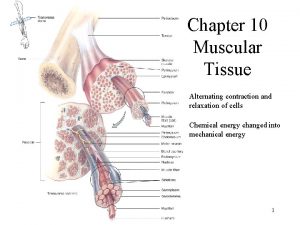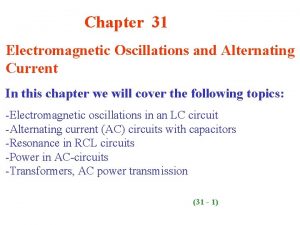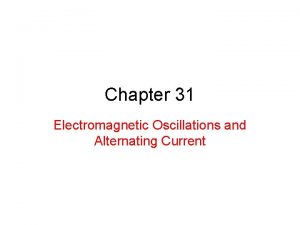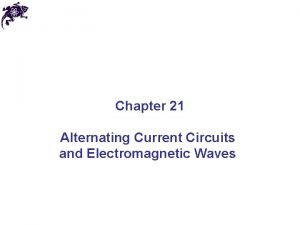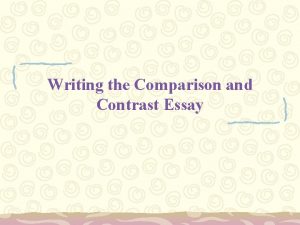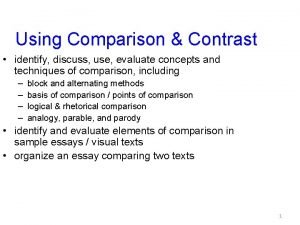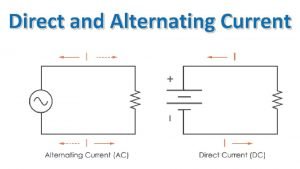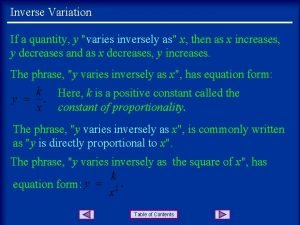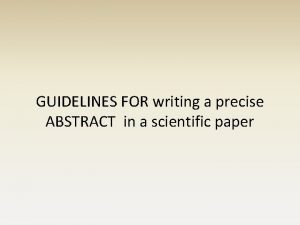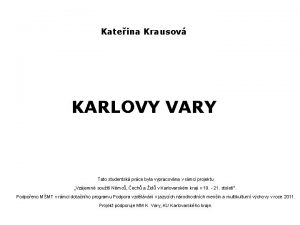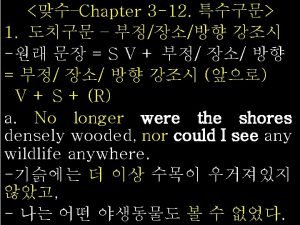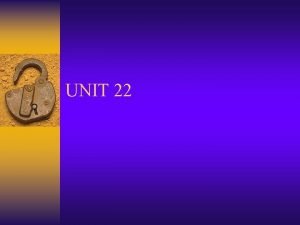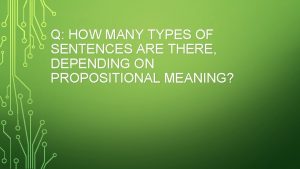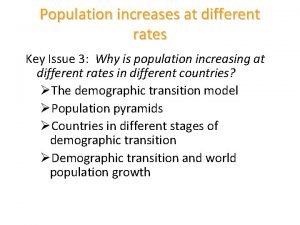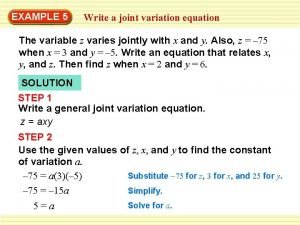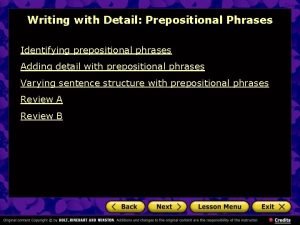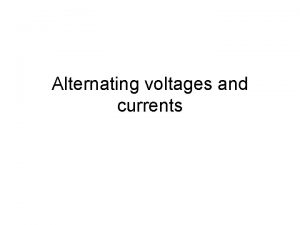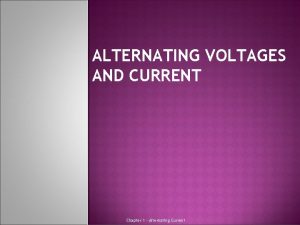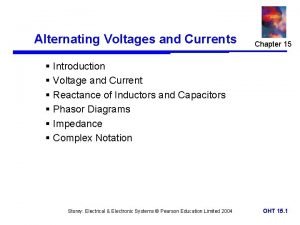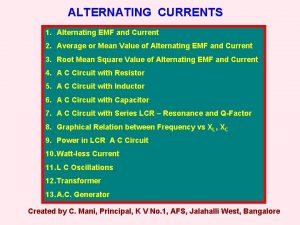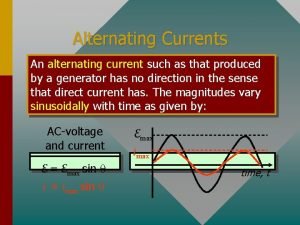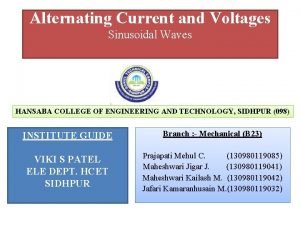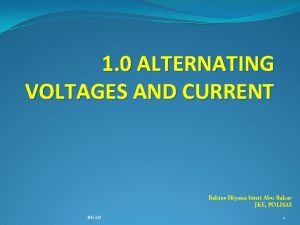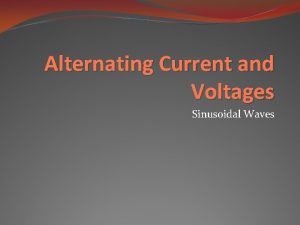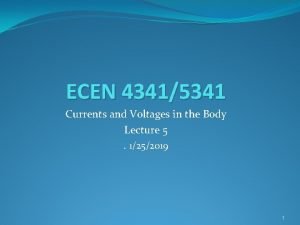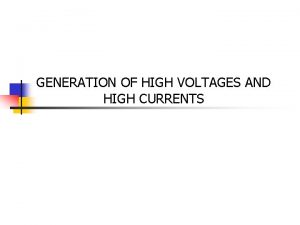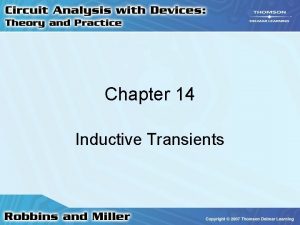V Alternating Currents Voltages and currents may vary































- Slides: 31

V. Alternating Currents Voltages and currents may vary in time. 5. 12. 2020 1

V– 1 Alternating Voltages and Currents 5. 12. 2020 2

Main Topics • • Introduction into Alternating Currents. Mean Values Harmonic Currents. Phase Shift 5. 12. 2020 3

Introduction into Alternating Currents I • Alternating currents are generally currents which vary in time and often even change polarity i. e. the charges flow in both directions in the course of time. • Usually by AC a subgroup of currents is meant, which is periodic and harmonic. But also some other shapes e. g. a square or sawtooth are of practical importance. 5. 12. 2020 4

Introduction into Alternating Currents II • We shall first define some general mean quantities which describe important AC properties. • Later we shall concentrate on the harmonic AC. They are important since: • they are being widely produced and used. • every function can be expressed using an integral or series of harmonic functions thereby it inherits some of its properties. 5. 12. 2020 5

The Mean Value I • The mean value <f> of an time-dependent function f(t) is a constant quantity, which has during some time the same integral (effect) as the time-dependent function. • For instance a mean current is a DC current which would transport the same charge over some time as would the time-dependent current. 5. 12. 2020 6

The Root Mean Square I • When dealing with AC qualities one more mean is needed: If there is a time-dependent current flowing through a resistor thermal energy loses will be at any instant proportional to the square of the current (the resistor doesn’t care about the direction of the current, it always heats). 5. 12. 2020 7

The Root Mean Square II • The root mean square frms of an time- dependent function f(t) is a constant quantity, which has during some time the same thermal effect as the time-dependent function. • Let’s for instance feed a bulb by some timedependent current I(t). Then if DC current of the value Irms flows through this bulb it would shine with the same brightness. 5. 12. 2020 8

Harmonic AC I • From practical as well as theoretical point of view harmonic alternating currents and voltages play very important role. These are quantities the time dependence of which can be described as a goniometric functions [sin( ), cos( ) or exp(i )] of time e. g. : V(t)=V 0 sin( t + ) I(t)=I 0 sin( t + ) 5. 12. 2020 9

Harmonic AC II • The parameters V 0 and I 0 are called the peak values and from the properties of goniometric functions, it is clear that V(t) and I(t) vary sinusoidally between the values –V 0 and V 0 or –I 0 and I 0. • From now on we shall mean by alternating voltages or currents the harmonic ones. 5. 12. 2020 10

Harmonic AC III • The AC voltage can be generated e. g. by the electromagnetic induction when rotating a coil of area A with N turns in uniform magnetic field B. In this case only the angle between the axis of the coil and the field changes. Let’s suppose the dependence: (t) = t • where = 2 f is the angle frequency and f is the frequency of the rotation. 5. 12. 2020 11

Harmonic AC IV • Then the flux through the whole coil is: m(t) = NABcos (t) • And the EMF: Vemf(t) = -d m/dt = NABsin( t) • This is an AC voltage with the peak value of V 0 = NAB. If this voltage is applied to a resistor R an AC current with the peak value of I 0 = NAB/R will flow through it. 5. 12. 2020 12

Harmonic AC V • Let’s note some important facts: • m(t) and Vemf(t) are phase-shifted by 90° or /2. When m(t) is zero Vemf(t) has a maximum. It is of course because the change of the flux m(t) is the largest. • V 0 depends on . 5. 12. 2020 13

Harmonic AC V • As we already have seen harmonic voltage is also output from the LC circuit, if loses can be neglected or compensated. • If we connect a charged capacitor to a coil, Kirchhoff’s loop law is valid in any instant: -L d. I/dt + Vc = 0 • This leads to a differential equation of the second order. Its solution are harmonic oscilations. 5. 12. 2020 14

The Mean Value II • It can be easily shown that the mean value of harmonic voltage as well as current is zero. • It means that charge is not transported but only oscillates and the energy which is transported by the current is hidden in these oscillations. 5. 12. 2020 15

The Root Mean Square III • It can be also easily shown that the rms values of harmonic voltage as well as current are non-zero. • If the mains AC voltage is 120 V it is the rms voltage Vrms = 120 V. So a bulb connected to this AC voltage or to the DC voltage of 120 V would shine with the same brightness. The peak voltage is V 0 170 V. 5. 12. 2020 16

The Phase Shift • We shall see that in AC circuits we have to allow a phase shift between the voltage and current. It means they do not reach zero and maximum values at the same time. • The power source gives some time-dependent voltage and the appliance controls how charge is withdrawn. • We describe this using the phase shift angle : • V(t) = V 0 sin( t) and I(t) = I 0 sin( t + ) 5. 12. 2020 17

Homework • Chapter 25 – 44, 45, 46, 47 • Chapter 29 – 28, 30, 31 5. 12. 2020 18

Things to read and learn • This lecture covers Chapter 25 – 6, 7; 29 – 4; 30 – 6; 31 – 1, 2 • Try to understand all the details of the scalar and vector product of two vectors! • Try to understand the physical background and ideas. Physics is not just inserting numbers into formulas! 5. 12. 2020 19

The Mean Value I • <f> has the same integral as f(t) over some time interval : Often we are interested in mean of a periodic function over a long time. Then we choose as representative time the period = T. 5. 12. 2020 ^ 20

The Mean Value II • <I> would transport the same charge as I(t) over some time : • The result of the integration is, of course, a charge since I = d. Q/dt. When divided by it gives a mean current over : 5. 12. 2020 ^ 21

The Root Mean Square I • frms has the same thermal effect as f(t) over some time interval : For a long-time rms, we again choose a representative time interval = T (or T/2)22^. 5. 12. 2020

The Root Mean Square II • Irms has the same thermal effect as I(t) over some time interval : Brightness of a bulb corresponds to the temperature i. e. thermal losses. 5. 12. 2020 ^ 23

The Mean Value III • Let I(t) = I 0 sin( t) and representative = T: Since the value of cos for the limits 0 and T is the same. 5. 12. 2020 24

The Mean Value IV • If I(t) was rectified it would be I(t) = I 0 sin( t) for 0 < t < T/2 and I(t) = 0 for T/2 < t < T: Since now cos( T/2) – cos(0) = -2 ! 5. 12. 2020 ^ 25

The Root Mean Square III • Let I(t) = I 0 sin( t) and representative = T: 5. 12. 2020 ^ 26

The Mean Value V Since now cos( T/2) – cos(0) = -2 ! 5. 12. 2020 ^ 27

LC Circuit I • We use definition of the current I = -d. Q/dt and relation of the charge and voltage on a capacitor Vc = Q(t)/C: • We take into account that the capacitor is discharged by the current. This is homogeneous differential equation of the second order. We guess the solution. 5. 12. 2020 28

LC Circuit II • Now we get parameters by substituting into the equation: • These are un-dumped oscillations. 5. 12. 2020 29

LC Circuit III • The current can be obtained from the definition I = - d. Q/dt: • Its behavior in time is harmonic. 5. 12. 2020 ^ 30

LC Circuit IV • The voltage on the capacitor V(t) = Q(t)/C: • is also harmonic but note, there is a phase shift between the voltage and the current. 5. 12. 2020 ^ 31
 Compared with surface currents deep currents are
Compared with surface currents deep currents are Generation of high dc voltage
Generation of high dc voltage Basic electrical tools and their uses
Basic electrical tools and their uses Alternating contraction and relaxation
Alternating contraction and relaxation Electromagnetic oscillations and alternating current
Electromagnetic oscillations and alternating current Electromagnetic oscillations and alternating current
Electromagnetic oscillations and alternating current Alternating current circuits and electromagnetic waves
Alternating current circuits and electromagnetic waves Alternating method compare and contrast
Alternating method compare and contrast Comparative essay example
Comparative essay example Direct and alternating current
Direct and alternating current How do individual use languages vary among places
How do individual use languages vary among places Vary your sentences
Vary your sentences Species vary locally
Species vary locally Species vary locally
Species vary locally Darwin's voyage of discovery
Darwin's voyage of discovery Pematex sokolov
Pematex sokolov Y varies inversely as x example
Y varies inversely as x example Abstracts vary by discipline
Abstracts vary by discipline Why does development vary among countries?
Why does development vary among countries? Answers vary
Answers vary Vary various variety
Vary various variety Simile openers
Simile openers Pr��ce karlovy vary
Pr��ce karlovy vary Key issue 3: why do individual languages vary among places?
Key issue 3: why do individual languages vary among places? People vary
People vary Vary various variety
Vary various variety Vary sentence length example
Vary sentence length example Why is it important to vary your sentences structures
Why is it important to vary your sentences structures Key issue 3 why does population growth vary among regions
Key issue 3 why does population growth vary among regions Varies jointly example
Varies jointly example Sentences with because
Sentences with because Some prepositions show time and place and others add detail
Some prepositions show time and place and others add detail

